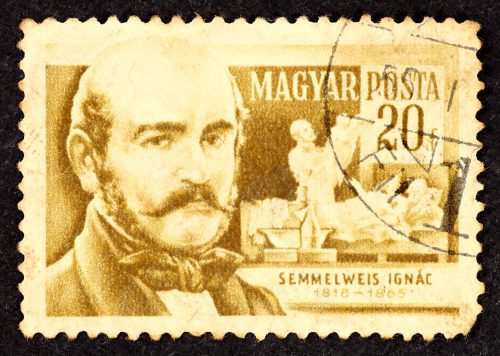One of the recommendations to combat the spread of the Covid-19 corona virus is to wash your hands with soap and water for 20 seconds. In the 19th century, a doctor named Ignaz Semmelweis lived in the Austro-Hungarian Empire, who was able to prove that disinfecting the hands of midwives during the transition from woman to woman drastically reduced maternal mortality. The scientific establishment mocked him and he ended his life in an insane asylum

One of the recommendations to combat the spread of the Covid-19 corona virus is to wash your hands with soap and water for 20 seconds. The reason for this - soap destroys the lipid (fatty) envelope of the corona virus. Today it seems obvious to us, but in the 19th century there lived in the Austro-Hungarian Empire a doctor named Ignaz Semmelweis, who was able to prove that the hand disinfection of the obstetricians during the transition from mother to mother or worse, from autopsy to mother, are the causes of the death rates from what was called "childbirth fever" ”, a disease that killed about a quarter of the births at that time.
But his life was not easy, thirty years before Louis Pasteur, it was not known that disease agents that pass from person to person are the causes of diseases, and the scientific establishment in Vienna stood on its hind legs and claimed that this was nonsense. The thought of the thousands of women who died in childbirth even though they could easily have been saved eventually caused him to have fits of rage and hospitalization in a psychiatric hospital, where he died.
In 2008, we published a series of articles by Dr.Roey Tsezana about the sad life of Dr. Zemelweiss, as part of a larger series about the history of science that dealt with the discovery of bacteria and later viruses. Here is part of the introduction to the series:
On medicine, science and puerperal fever - the tragedy of Dr. Ignaz Semmelweis
The close connection between Zemlvis and puerperal fever began when the young Hungarian doctor was hired as assistant to the director of the maternity department at the General Hospital of the city of Vienna in 1846. The hospital was part of the University of Vienna and had a combination of research institutes and hospital rooms. Although the hospital was one of the most successful in Europe, harsh conditions of overcrowding and lack of hygiene prevailed. In those years, they had not yet understood the connection between bacteria and dirt, and the smell that prevailed in the hospitals would turn the stomachs of the visitors: a pungent and pungent smell of decay, filth and human needs. Doctors would not wash their hands, and would often finish an operation after death and immediately proceed to deliver a young woman. Under these conditions, it is no wonder that the maternity ward of that hospital had a mortality rate of 11.4% among the women giving birth. The real wonder was that in the second maternity ward of that hospital, where professional midwives were trained, the mortality rate was three times smaller, of 2.7%. Although even these mortality rates sound extremely high to us, the Vienna hospital was a real medical miracle, as other hospitals throughout Europe reported mortality rates of 20-25% at the same time.
In 1847, the incident occurred that caused Zemlweis to finally form his opinion about puerperal fever. His friend, Professor Jacob Kolczka, performed an autopsy along with several students. During the autopsy, Kolchaka's finger was stabbed by the surgical knife he was using. Although the wound was small and the bleeding was marginal, after a short time Kolchaka fell into bed due to acute inflammation of the lymphatic vessels, the arteries in the upper body, the membranes of the lungs and chest, the sac surrounding the heart and the membranes surrounding the brain. Zemlweiss describes that as soon as he heard how his friend died, he realized that the signs of widespread inflammation throughout the body were the same as those appearing in women who died of puerperal fever.
Zemlweiss developed the idea further, and decided that inside the dissected corpses there are 'particles of decay' which can stick to the surgical instruments and the fingers of the surgeons. When these decay particles are transferred into the body of a woman giving birth, they cause inflammation and puerperal fever. Zemlweis believed that further proof of this idea can be found in the connection between the degree of opening of the vagina and the chance of contracting puerperal fever. The more the vagina is opened, the more chance there is that the decay particles will be able to penetrate into the mother's body. This simple theory also explained the difference in mortality between the two classes. In the first department, the medical students were trained, and they used to perform surgeries on Gentiles in the mornings. The surgeries were done with bare hands, and when the students finished the surgeries, they did not wash their hands. As we have already mentioned, the custom of washing hands was not common at that time among doctors, and the students walked the corridors of the hospitals with their hands giving off a pungent smell of decay and death. When the students would give birth to the pregnant women, the particles of rot would pass from their palms into the vagina, and from there into the uterus. Since only midwives were trained in the second department, they did not have to perform surgeries on corpses, and therefore there were no particles of decay on their palms.

The irony of fate is that if Zemlweis had revealed the same discovery thirty years later, the whole world would have hailed him as a miracle. Only twenty years after Semmelweis's discovery, Pasteur finally proved that bacteria do not arise from nothing, but are transmitted from person to person. Obviously the two ideas are interrelated, and all that was needed was a good microscopist to spot the 'particles of rot' which are nothing but bacteria. But this period had not yet arrived, and Zemmelweis had to make his way in the medical community and find a way to convince his fellow doctors of his theory. In this area, Zemmelweis's greatest enemy was himself. Apart from a small number of friends, he was a lone wolf. His hot temper, which reached almost psychosis in extreme cases, alienated him from the company of most people. Scientists, as well as most of the hospital staff, did not willingly approach Ignaz Semmelweis. And perhaps worst of all - Zemmelweis was an extreme liberal, and took part in demonstrations and other actions against the government. He was subsequently fired from his job for these positions. It is easy to understand, therefore, why no one wanted to approach the mad doctor, and why, when he presented his ideas to the head of the department, he threw him out of his room without a second thought.
For the full series of articles:

14 תגובות
Ladies and gentlemen, what would we do without you? You have the power to throw and throw...or bury...as long as you used your power correctly, there would be men and women in the world and light in the house. But today due to "progress and equality between the woman as an electricity company and the man as a consumer, the woman became a consumer" who put you in reverse, you lost the power of your electricity company and became a supplier to a consumer and the light of the house went out and when the thinking head went and managed the order of the man and the house, they worked on you like in the ancient garden... and this is where the presenter appeared. The new .. the sitter... and the light of the thinking head was replaced by the darkness of the sitter... and the world became female and male and the mating arrangements were confused who against whom, where they come from and where they are going... and even girls, show me a coachman who asks his donkey for equal rights..
H
Which women said that first? Do you have a source?
Women said it long before anyone else. it's always been like this. But even today when a woman asks a man to wash his hands, he mocks her. And even insulted to the point of murdering her.
And there are the extreme rare men who wash their hands all day and destroy families.
Women said this long before him and long before Judaism and before Hinduism and before everyone else. That's why they were mocked, among other things.
Why does it matter if he was Jewish? It doesn't mean anything, after all the repugnant rapists in Cyprus are also Jews, aren't they? Rabbi too? Berlad is Jewish, isn't he? There are many unsympathetic examples, there is no connection between a Jew and a Jew,
for a bee
It is about Florence Nightingale and the war is the Crimean War 1853-1856.
Ronen
I did not know that.
It turns out that restrictions were imposed on him because he was Jewish.
https://www.pbs.org/newshour/health/ignaz-semmelweis-doctor-prescribed-hand-washing
Here too we see that Judaism was 2000 years ahead..
There is a charge for washing your hands every time you leave the bathroom or before eating, and after the meal there is a charge for "last water" which is additional washing and cleaning of your hands
An interesting and insightful article. My heart aches for Zemlweiss, whose whole intention was to save lives...
Give a reliable source
Is it difficult for you to point out that he was Jewish?
bee
Zemlweiss is the man to whom we owe so much
Very nice article, thank you.
Hi Gila
Sorry for the past
Because maybe I'm wrong
I think that during the Second World War, it was a nurse who noticed the connection between
The surgeons who did not observe hygiene, and among the deaths of the soldiers.
Checking and getting back to you